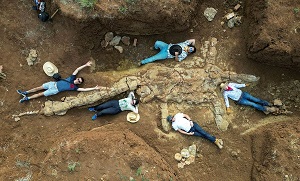 New Marine Fossil Found in Outback Queensland
New Marine Fossil Found in Outback Queensland

Three amateur palaeontologists have discovered the remains of a 100-million-year-old long-necked marine reptile at an outback Queensland station. | In an Australian first, the complete skeleton of an ancient plesiosaur, an extinct marine reptile, was discovered at a sprawling remote property in the McKinlay region in what has been described as the Rosetta Stone of marine reptile palaeontology. ● A team of museum palaeontologists travelled to the remote site to collect the fossil of the elasmosaur, a plesiosaur that lived alongside the dinosaurs. The Elasmosaurus lived in the Eromanga Sea, which covered large parts of inland Australia between 140 and 100 million years ago. There are well over a hundred species of plesiosaurs currently known worldwide—some had long necks and small heads, and some had short necks with giant heads. Elasmosaurus came to the water’s surface to breathe air and had slender teeth for catching fish, crabs and molluscs. Scientists have discovered plesiosaur fossils with stones in the stomach area, showing they swallowed stones (called gastroliths) to either grind up food in their stomachs or as ballast to aid in diving. ● Queensland Museum Network CEO Jim Thompson, PhD, said the find would help paint a comprehensive picture of Queensland’s Cretaceous marine reptiles.




